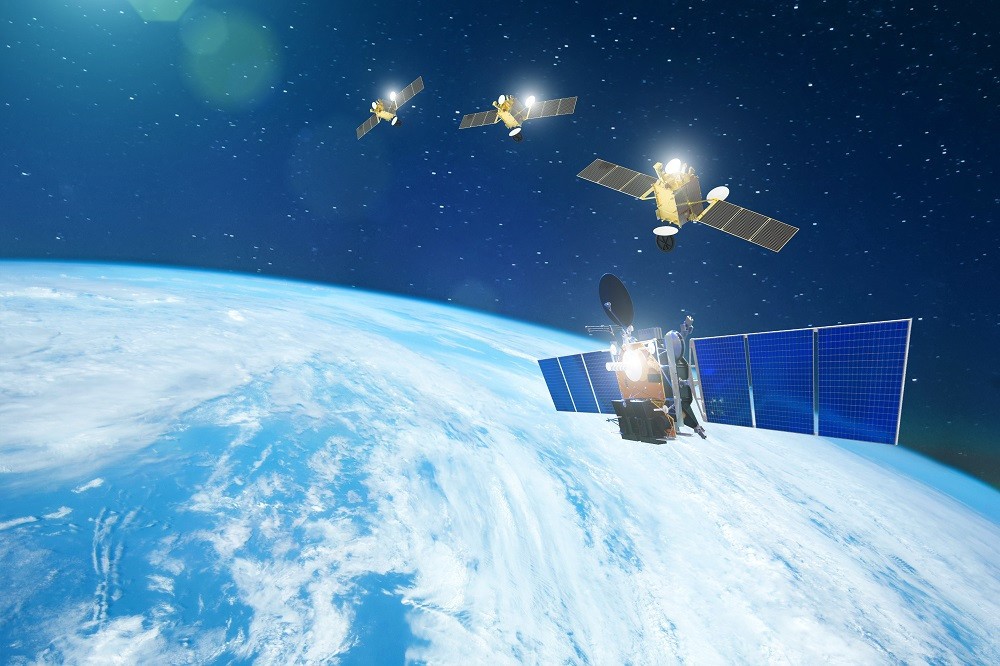Article: Defining New Space

Though there is no true consensus on what is meant by “New Space,” it can be said that the term covers an emerging industry and movement in the field of space and space technology development. In contrast to the traditional methods employed by government space agencies such as NASA in the United States or ESA in the European Union, which have been modified and adapted meet the needs of these new trends, New Space is marked by the proactive involvement of private companies and entrepreneurs who are driven to innovate and market space solutions, as well as venture capital investors seeking to expand their investment portfolios.
The New Space industry covers a wide range of companies, from major corporations to startups, involved in specific fields such as space technology, telecommunications, space tourism, launch services, Earth observation, asteroid mining, etc. Some of the key aspects of New Space are as follows:
Private companies: New Space does not depend heavily on public agencies but rather is focused on private investors’ development and operation of space technology.
Cost reduction: one of the main goals of New Space is to significantly reduce the costs associated with access to space, also known as the “democratization” of space. This goal is achieved by reusing components or systems in the production of rockets and spacecraft and by taking more industrial approaches to the design, construction, production, and validation of all the elements of a space mission.
Technology innovation: New Space has promoted innovation in several fields of space technology, with examples including the development of reusable rockets and the creation of advanced spacecraft and more efficient propulsion systems that are smaller and lighter but offer end users higher-quality services.
Commercialization of space: in addition to traditional governmental missions, New Space seeks to exploit space for commercial applications such as space tourism, asteroid mining, Earth observation, and satellite constellations for global connectivity.
Competition and collaboration: as more companies break into the space market, competition has intensified, accelerating the pace and efficiency of developments. At the same time, some of these companies work with public space agencies on joint projects.
Access to low Earth orbit: New Space has made it possible to gain greater access to different orbital levels (LEO, GEO, MEO, Exploration, and Interplanetary). Access to low Earth orbit (LEO) is particularly notable and has led to the proliferation of satellite constellations with several applications, such as communications, Earth observation, and weather monitoring.
Development of space ecosystems: New Space has promoted the growth of wide-ranging space ecosystems that bring together space tech companies, investors, startups, and universities working together on the expansion of the space industry.
In a nutshell, New Space has brought about a revolution in the space industry by increasing the participation of the private sector, theoretically boosting technology innovation, and reducing the costs of access to space. The participation of the business sector, driven by a significant presence of private investors in space projects, has resulted in a diversification of space applications and opportunities, including the development of the space tourism industry, asteroid mining, Earth observation, and the expansion of global connectivity through satellite constellations, leading to significant growth in the space industry in recent years.

The origin of New Space
The emergence of New Space is thanks to the convergence of a number of different factors in recent decades. These factors have brought about a significant shift in how we approach the space industry and space exploration. Some of the drivers of New Space are as follows:
Technological progress: technological progress in fields such as computer science, electronics, propulsion, and manufacturing has made it possible to create more advanced and efficient space systems. This, in turn, has made space more accessible and has opened the door to new innovation opportunities.
The reuse revolution: companies such as SpaceX have demonstrated the feasibility of reusing rockets and spacecraft, significantly reducing launch costs and transforming the economics of the space industry.
Commercial interest: recognition of the commercial opportunities space offers (examples include space tourism, the creation and exploitation of a permanent colony on the Moon, asteroid mining, Earth observation, and satellite constellations for global connectivity) has attracted investors and entrepreneurs seeking to capitalize on these opportunities.
Deregulation and favorable government policies: certain countries have implemented policies that promote private sector investment and participation in space exploration. This has paved the way for private companies to become involved in space activities.
Competition: competition among private companies in space has spurred innovation, translating into cost reduction and greater efficiency. Companies compete to offer high-quality space services at competitive prices, benefiting consumers and public space agencies.
Democratization of access to space: New Space also pursues the democratization of access to space by significantly reducing development and implementation costs. For example, it seeks to increase the availability of launch services, a key element in the deployment of space missions. This makes it possible for a wide range of players, from small startups to major companies, to develop their innovative businesses and ideas.
In short, New Space has come about as the result of a combination of technological progress, commercial incentives, favorable government policies, and greater competition within the space industry. This shift has led to a revolution in space exploration and exploitation, with a greater emphasis on the participation of the private sector and technological innovation.

Is New Space sustainable?
Sustainability, not just in New Space but in other contexts as well, is a key concept, and one that is constantly changing. As the space industry grows and diversifies, sustainability issues must be considered and addressed in order to ensure that space exploitation will be responsible and have a long-term vision. Sustainability issues in relation to New Space include the following:
Security and responsibility: the use of space on a massive scale by an increased number of companies and new players raises concerns about security and responsibility in the event of accidents or conflicts in space. International regulations and agreements must be established to address these issues and minimize the significant environmental impact on the Earth and in near space. Care must be taken to minimize negative impacts.
Management of space debris: one of the most pressing challenges in terms of sustainability is the growing accumulation of space debris in the Earth's orbit. Collisions and the accumulation of fragments pose a risk to spacecraft and satellites in orbit. The space community is working on measures to reduce, clean, and actively mitigate space debris.
Efficient use of resources: sustainability is also linked to the efficient use of resources in space. This includes the efficient management of fuel and energy, as well as minimizing space pollution.
Reusing and recycling: the focus on reusing rockets and spacecraft, which has been one of the key features of New Space, can be considered sustainable, as it reduces the need to manufacture new vehicles for each launch. Furthermore, the ability to recycle space components can also contribute to sustainability.
Environmental concerns: the environmental impact of space activities, such as rocket emissions and space pollution, is also a sustainability issue, and must be monitored and kept to a minimum.
Ethics and responsibility: sustainability in space also has to do with ethical issues and responsibility. This includes taking into account possible interference with celestial entities, preserving places of scientific interest, and managing space resources in a fair and equitable manner.
International standards and regulations: effective international standards and regulations that address issues such as debris management, orbit coordination, and liability for damage caused in space, are needed to promote sustainability in space.
Overall, the sustainability of New Space is a growing concern and a priority for the space community and industry. As space exploration and activity continue to expand in scope, it is expected that additional measures will be put in place to address these challenges and guarantee a sustainable and responsible use of space. There are currently significant initiatives in progress both in Europe and the United States that seek a way to safely regulate access to space, with approaches drawing from experiences in the field of air traffic control.

Is New Space profitable?
Sustainability, not just in New Space but in other contexts as well, is a key concept, and one that is constantly changing. As the space industry grows and diversifies, sustainability issues must be considered and addressed in order to ensure that space exploitation will be responsible and have a long-term vision. Sustainability issues in relation to New Space include the following:
Security and responsibility: the use of space on a massive scale by an increased number of companies and new players raises concerns about security and responsibility in the event of accidents or conflicts in space. International regulations and agreements must be established to address these issues and minimize the significant environmental impact on the Earth and in near space. Care must be taken to minimize negative impacts.
Management of space debris: one of the most pressing challenges in terms of sustainability is the growing accumulation of space debris in the Earth's orbit. Collisions and the accumulation of fragments pose a risk to spacecraft and satellites in orbit. The space community is working on measures to reduce, clean, and actively mitigate space debris.
Efficient use of resources: sustainability is also linked to the efficient use of resources in space. This includes the efficient management of fuel and energy, as well as minimizing space pollution.
Reusing and recycling: the focus on reusing rockets and spacecraft, which has been one of the key features of New Space, can be considered sustainable, as it reduces the need to manufacture new vehicles for each launch. Furthermore, the ability to recycle space components can also contribute to sustainability.
Environmental concerns: the environmental impact of space activities, such as rocket emissions and space pollution, is also a sustainability issue, and must be monitored and kept to a minimum.
Ethics and responsibility: sustainability in space also has to do with ethical issues and responsibility. This includes taking into account possible interference with celestial entities, preserving places of scientific interest, and managing space resources in a fair and equitable manner.
International standards and regulations: effective international standards and regulations that address issues such as debris management, orbit coordination, and liability for damage caused in space, are needed to promote sustainability in space.
Overall, the sustainability of New Space is a growing concern and a priority for the space community and industry. As space exploration and activity continue to expand in scope, it is expected that additional measures will be put in place to address these challenges and guarantee a sustainable and responsible use of space. There are currently significant initiatives in progress both in Europe and the United States that seek a way to safely regulate access to space, with approaches drawing from experiences in the field of air traffic control.
GMV as part of New Space
When GMV was founded in 1984, it could be described as a startup. It emerged as a Spanish university spin-off and was a pioneer in New Space at the time, though its origins and subsequent development were shaped by its connection with the European Space Agency (ESA) and the development of space programs in Europe at an institutional level. This in itself speaks to a difference between the mid-1980s and today's day and age, where private initiative clearly has a greater presence.
GMV is currently an industrial group with over 3,000 employees and is internationally renowned for both relevance and the quality of its projects. It is the sixth-largest space industrial group and the top medium-size (Midcap) space company in Europe.
From the beginning, GMV has been committed to continuous investment in R&D, the ongoing pursuit of innovation in its processes and developments, and the diversification of its activities, without being daunted by the technological challenge all of this may entail. This last point in particular has always been at the very core of the group's identity, and will undoubtedly be part of its future. In one way or another, GMV has been able to adapt to the most demanding and competitive settings, which is why it’s safe to say the company is part of New Space as defined in this article.
GMV is also a driver of new and currently emerging companies and projects that are shaping the development of New Space. Specifically, GMV plays a crucial role in the Miura 1 project by PLD Space, leading the development of avionics, software, and GNC (guidance, navigation, and control) systems for the company's micro-launcher. GMV’s involvement is pivotal for the future success and consolidation of this family of launchers, as well as its market profitability in the not-too-distant future. This was clearly a major technological development and a step forward for GMV in terms of its capabilities.
And GMV has recently taken an even bigger step, incorporating the startup Alén Space into the group with the goal of more efficiently penetrating the current market and providing this company with the support and boost it needs. The new ideas and capabilities Alén Space contributes will be driven by the experience and support GMV can offer.
Through cutting-edge technological projects, giving momentum to companies with a promising profile in the space sector and assisting in the process of developing and integrating innovation, success is guaranteed in a highly competitive environment such as New Space.